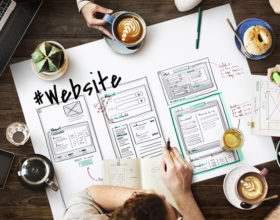Enhancing The User Experience: Designing Your Website Like a Top Department Store
 The best websites are similar to the best department stores. Visitors want to get inside and find what they’re looking for in a snap. If your website is slowing them down, that’s bad. Here’s how applying the department store theory to your website design can make all the difference in the world – regardless of where your customers reside.
The best websites are similar to the best department stores. Visitors want to get inside and find what they’re looking for in a snap. If your website is slowing them down, that’s bad. Here’s how applying the department store theory to your website design can make all the difference in the world – regardless of where your customers reside.
Make Sure Your Customers Can Read And Understand The Content
This seems so obvious, but sometimes, websites get this very, very, wrong. If your customers speak a foreign language, make sure the site is translated properly. You can use automated services like this, like Google’s translator, but you should also have Translatebyhumans.com look it over, to make sure that you’re not losing something (like, the meaning of your ad copy or your content) in that translation.
For example, some words simply don’t translate well into other languages. And, even when they do translate, there can be differences in the connotation or subtle meanings of words or phrases that an automated translator won’t catch.
A human will.
And, according to Ian Humphreys, regional director for Caliber, a digital marketing agency, companies that don’t engage with people in their native tongue miss a vital connection with those people and may even lose sales or the entire market.
Provide Continuity
Apple has figured this out, and does a really good job with it: Continuity. When you move from your laptop to your mobile phone, how does the site look? Is it clunky? Are there elements that don’t translate very well? Do color schemes get messed up?
All of this needs to be sorted out before you start advertising to a market that uses different devices than what you do.
So, for instance, if your site looks great on a laptop, but the majority of your market uses a smartphone to access the web (as is the case in Asia), then you had better make sure the mobile site looks amazing.
If it doesn’t, you’ll lose people – fast.
Make Navigation Intuitive
When you walk into a store, it’s pretty obvious where the socks and underwear are. Likewise, you know where the men’s department is versus the women’s department. The store is “intuitive.” Make your navigation that way.
Intuitive navigation means that people don’t have to guess as to what they’re supposed to do or how to get around your site. Are your navigation buttons easy to find? Do they take people to pages that users would expect them to?
Are the nav buttons intelligently named?
This all might sound very basic, but a lot of businesses still aren’t doing this properly, according to usability experts at Normal Nielsen Group. Make sure yours is, and that your users aren’t struggling with what Normal Nielsen Group called “cognitive strain.”
Let Users Control The Content Flow
Website users are mostly scanners. That is, they don’t read every single word. They scan. When your website design impedes that, it breaks usability and could hurt sales. In a department store, things are laid out in such a way so as to encourage users to walk along a defined path. But, if users want to make their own path, the store makes it easy to get to wherever a shopper wants to go.
So should it be with your site. If there are no headings, buttons, or obvious visual cues that are normal for a reputable website, users will bounce.
So, clean up the layout of your blog posts, pages, and the navigation area. Let users scan the content, and guide them toward solutions to their problems by not impeding or hiding links or valuable content on the site.
Make The Content Load Fast
The faster, the better. In general people don’t want to wait longer than 3 seconds for a page to load. Some website visitors will tolerate a longer wait time, but not many. One way you can speed up load times is to run a Google PageSpeed test.
Remove all of the ads from your site, and any other superfluous “content” that is distracting to users. So many websites refuse to follow basic site design and layout that they completely break the user experience.
For example, don’t make the user scroll down halfway to see the content. Not only do users find that annoying, it may hurt your rankings in Google.
Slow-loading pages can also be fixed by taking a look at your site’s architecture, how javascript loads, whether the site’s images are optimized for loading times, and a few other factors. Things like self-hosted videos and large image files or PDFs can really drag a site down. Fix that and you should see visitor counts perk up.
Author
Alpi Mantry is in the business of “Delivering Happiness” – Alpi is heading the relationship and growth portfolio for a revolutionizing Translation startup in London that has a list of Happy Customers which includes Vogue, Waze (Google), Gulfstream, HSBC Europe and more. After having worked with top corporates, Alpi has joined this startup to utilize her dynamic management skills polished in the last 10 years. She enjoys sharing her insights online.





